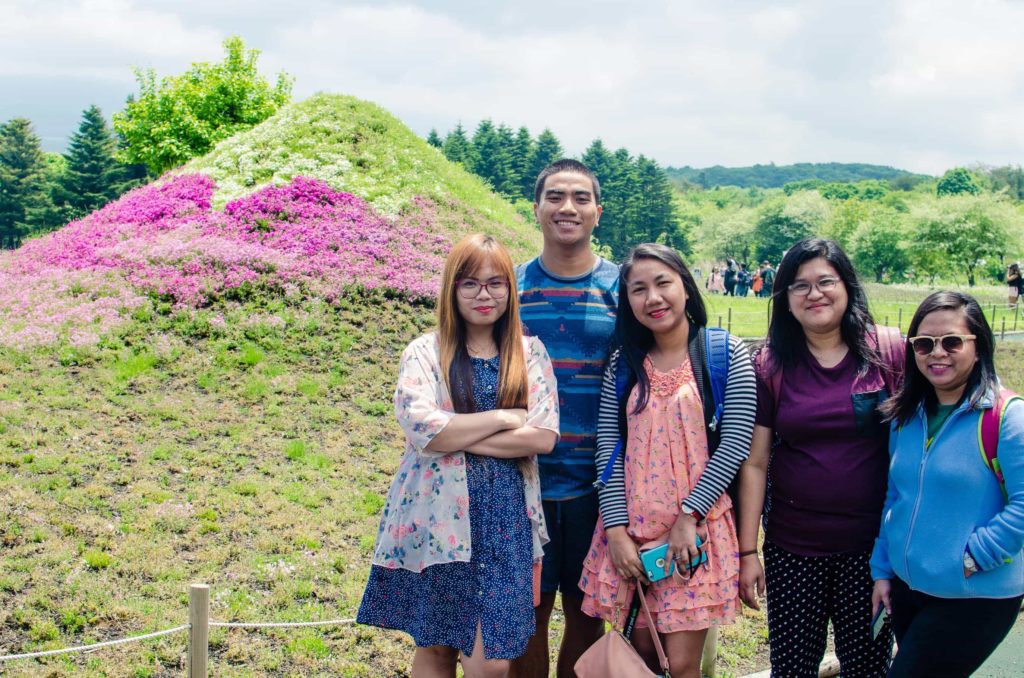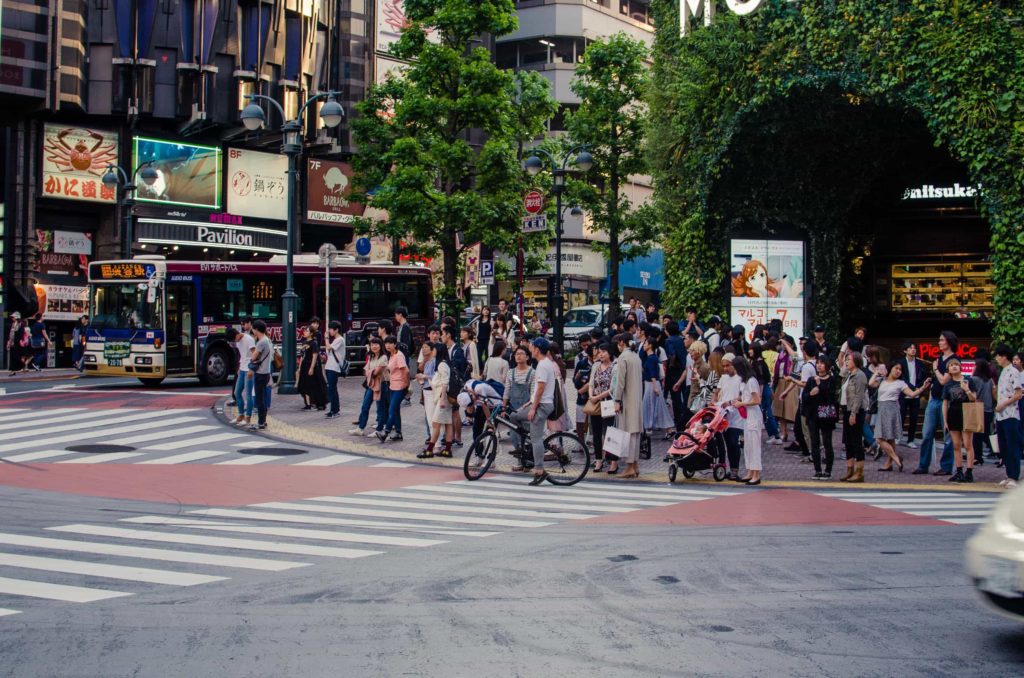After months of procrastination, we’ve reached Japan 2017 day 2! I swear I did not realize it’s been a year since that trip. I’ve put off blogging about Fuji Shibazakura Festival because it was one of my most favorite festivals in Japan, that I didn’t want to do a hurried entry of it. The photos on this blog entry might not be the most well-composed pictures but they’re some of my favorites from that day, so here we go!

Table of Contents
Fuji Shibazakura Festival
Fuji Shibazakura Festival is an annual festival at the at Fuji Motosuko Resort, which is located at the base of Mt. Fuji. The stars of the festival are the hundreds of thousands of pink phlox mosses (shibazakura) and the majestic views of Mt. Fuji. The venue also turns into a food festival where various food stalls offer delicious regional dishes for everyone to enjoy. The festival happens usually from mid-April to mid-May so check out their official website to confirm the Fuji Shibazakura Festival dates if you plan to go.

Travel to Fuji Shibazakura Festival from Tokyo
We woke up very early on our second day in Tokyo to catch the earliest train going to Otsuki Station from Shinjuku Station. It took about 70 minutes until we reached Otsuki (Asuza train is covered by JR Pass). From there, we boarded another train going to Kawaguchiko Station. Travel time was 50 minutes and one way fare was 1,140 yen (not covered by JR Pass). Finally, we boarded the Shibazakura Liner, the dedicated bus line going to the Shibazakura festival venue. The round trip bus fare and entrance fee was 2,000 yen.
Check out this detailed travel guide to learn about how to get to the venue from Tokyo.

Project Gora Tip: If you plan to see Mt. Fuji, monitor the weather forecast particularly in Shizuoka, the home of Mt. Fuji. The forecast changes day by day so be flexible with your travel plans. Your time, money and effort will just go to waste if it’s too cloudy or hazy.
Activities at the Fuji Shibazakura Festival
We arrived at the festival’s venue at around 9:30 AM. It was already the last day of the festival so naturally there weren’t many shibazakuras to see. It wasn’t the best day to see Mt. Fuji either because it was sunny but hazy at the same time. In spite of that, the venue was jam-packed with both local and foreign tourists. Thankfully, there were lots of sights to see that day like the mini-concert and mini-magic show, the forested mountain and the lake, and of course other festival goers who were obviously enjoying the day.

As for us, we went shopping for some souvenirs and we also enjoyed delicious snacks and desserts from the food stalls. Every festival in Japan has its own characteristics but one thing that you would probably notice is that they always showcase the region’s local produce or specialty.
Overall, I did enjoy our time in Fuji Shibazakura Festival. It was a little sad that we did not get to see the pink carpet of shibazakuras and Mt. Fuji, but experiencing a Japanese festival is always a delight! It was very heartwarming to see Japanese families and friends come together to celebrate nature’s beauty. Arguably no other country in the world celebrates blooming of flowers like shibazakura and sakura (cherry blossom) with the same enthusiasm as Japan.

Other Places to Visit from Fuji Shibazakura Festival Venue
Since you are already in the Fuji Five Lakes area, you may explore other must-visit places like Chureito Pagoda (the iconic five-storied pagoda), Lake Kawaguchiko, Oshino Hakkai, Kachi Kachi Ropeway, or maybe Gotemba Premium Outlets if you love shopping.
Harajuku, the Center of Japanese Pop Culture in Tokyo
After lunch, we decided to head back to Tokyo so we can explore Harajuku and Shibuya. It was around 3:00 PM when we arrived in Harajuku Station with a couple of train transfers all the way from Kawaguchiko Station. Harajuku was super crowded, as usual. Unlike the other shopping districts in Tokyo, it has a quirky and unique vibe.

Most of the shops here sell different kinds of lolita outfits and other peculiar stuff. Takeshita Street, the photo above, is particularly busy any time of the day. Tourists would usually take a picture of this street when it’s super jam-packed with people before they walk down for some shopping/window shopping.
Takeshita Street is also home to some of my favourite pasalubong stores like the famous 100-yen shop, Daiso, snack bars like Calbee Plus, and of course the Harajuku-icon Marion Crêpes.

Project Gora Tip: If you think Harajuku is only about the kawaii culture, then you are in for a huge surprise. Some of Tokyo’s most popular spots are located in or near this district. Meiji Jingu and its iconic wooden torii gates are located just a short walk from Harajuku Station. On the other side of the shrine, you will find one of Tokyo’s green lungs, Yoyogi Park. If you love luxury brands and high-end restaurants, then you may go to Omotesando located just right next to Harajuku.

Ramen Fix at Afuri Ramen
So after some shopping at Harajuku, we went to Afuri Ramen which is about 5-minute walk from Harajuku Station. We decided to eat dinner early so we can try this hghly-rated ramen restaurant based on TripAdvisor reviews. And because it was quite popular, there were lines of customers waiting to get in when we arrived. We waited for about 20 minutes until each of us got our own seats. Just like the other ramen places in Japan, orders were made using the ramen vending machine.

Instead of getting their signature Yuzu Shio Ramen, I opted for Yuzu Ratanmen, which looked spicy on the picture in the vending machine. My bowl of ramen arrived fast and I could easily tell that it was made from high-quality ingredients. It seriously did not look like other ramen noodles I’ve tried before. My ramen was made from chicken and dashi-based spicy broth with Hokkaido-style thin-noodles, tamago (egg), chasu (grilled pork), nori (seaweed), menma (bamboo sprouts), and mizuna (spider mustard). So what can I say about it? ABSOLUTELY DELICIOUS.
Shibuya, One of Tokyo’s Main Commercial and Business Hubs
We ended the day at Shibuya, home to the iconic Shibuya Crossing, arguably the busiest intersection in the world. I’ve crossed this street countless times but it has this certain vibe that you won’t probably get in any other pedestrian crossings in the world. Truly, nothing says “Welcome to Japan” better than this.

It was a super tiring but fulfilling second day in Japan. If you are travelling in the land of the rising sun from mid-April to end of May, I highly recommend including Fuji Shibazakura Festival in your itinerary. Don’t feel sad if you missed the sakuras or cherry blossoms because there are other flowers or species of cherry trees that are still in full bloom after the first week of April. Also, there are other festivals worth seeing! You will never run out of things to see and do in Japan, seriously!
Where to Stay in Tokyo
Andon Ryokan
2-34-10 Nihonzutsumi, Taito 111-0021, Tokyo Prefecture
Grids Hostel Asakusabashi
4 Chome-11-6 Asakusabashi, Taitō, 111-0053, Tokyo Prefecture
Comfort Hotel Tokyo Higashi Nihonbashi
1-10-11 Bakurocho, Nihonbashi, Chuo 103-0002, Tokyo Prefecture

